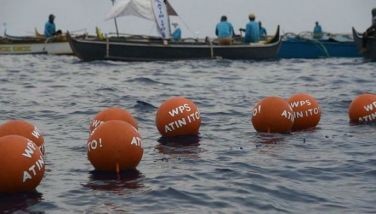Sandwiched between two major powers

The upcoming visit of US Vice President Kamala Harris tomorrow to the Philippines brings us right into the center of international attention, most especially with her itinerary that includes a high-profile trip to Palawan province which is located near the Spratlys. Observers are already predicting that the Palawan visit – which includes a tour aboard a Philippine Coast Guard vessel around Puerto Princesa City – may be interpreted by our neighbor to the north as a “rebuke,” with the turn of events being a cause of “irritation.”
But whatever it is, we must remember that from day one of his presidency, President Ferdinand Marcos Jr. has been consistent in communicating to the international community that we have a clear foreign policy that strives in no uncertain terms to be “a friend to all and an enemy to none,” focusing on rebalancing relations with existing and new allies.
Certainly, we value our oldest and only treaty ally, the United States, but we also want to work with other countries including China, and this has been evident during the President’s state visits and bilateral meetings with other heads of state. However, there is no avoiding the fact that we have an issue with China regarding disputed territories, with the Philippines obtaining a favorable ruling from the arbitral court in The Hague, Netherlands in July 2016 that junked China’s historic claims on the South China Sea on the basis of its so-called nine-dash line.
During his meeting with the Asia Society in New York last September, the President was unequivocal in saying that the position that the Philippines takes is that “we have no territorial conflict with China” because what we have is “China claiming territory that belongs to the Philippines.”
Nevertheless, the President is intent on working with China and other claimant states with the end in view of “resolving the issues involving the West Philippine Sea through diplomacy and dialogue,” he said.
The President reiterated this message during the recently concluded ASEAN summits when he pushed for the early conclusion of the Code of Conduct in the South China Sea as this is envisioned to help reduce the risk of conflict. He also called on leaders to be guided by the Treaty of Amity and Cooperation in Southeast Asia (TAC) that outlines universal principles of peaceful coexistence and cooperation, particularly among the “high contracting parties” such as the ASEAN member-nations and others that include the US, China, Japan and Russia.
Likewise, he highlighted the potential of the South China Sea to become “a nexus of vibrant economic engagements and interactions” and “not an epicenter of armed conflict or geopolitical maneuverings.”
With that having been said, the in-person meeting between President Joe Biden and President Xi Jinping during the G-20 summit in Bali, Indonesia is seen by many as a right step towards de-escalating the tension between these giants, as both have promised to put more effort into repairing “a relationship that has been at its most rancorous point in decades,” went an article in the New York Times.
“None of that hid the deeply divergent views behind their disagreements, including over the future of Taiwan, military rivalry, technology restrictions and China’s mass detentions of its citizens. But with the stakes so high, both Mr. Biden’s and Mr. Xi’s language represented a choice not to gamble on unrestricted conflict but to bet that personal diplomacy and more than a decade of contacts could stave off worsening disputes,” the NYT succinctly put it.
“But neither leader went into the meeting expecting the other to concede on their major areas of disagreement. The point, they said, was to keep lines of communication open to prevent the relationship from devolving further,” the New York Times article pointed out.
In a report written by Don McLain Gill and Joshua Bernard Espeña published at geopoliticalmonitor.com, they pointed to the “critical role” that the Philippines – a middle power – can play in the “overall power equation as the US and China battle for influence in the Indo-Pacific.” The country’s strategic location serves as a tipping point in the rivalry as it has “the potential to change the balance of power” between these two giants and can “cause major power shifts in the greater Indo-Pacific region.”
One important factor is that a large majority of Filipinos consider the United States as the most trusted nation and believe President Marcos should assert our rights in the West Philippine Sea. At the same time, they also do not want the Philippines to be like ham in a sandwich – caught between two slabs of bread and be gobbled up in the end.
As I pointed out on many occasions, any conflict can only lead to death and destruction as we are seeing in the war in Ukraine, and the only way out is through continuing dialogue and diplomacy. While critics may say that what has been happening so far is all talk, that is still by far better than engaging in warfare. My ASEAN colleagues in Washington and I have always maintained that the only way to peace is through the continuing conduct of dialogue and diplomacy, a position that the Philippines continues to advance.
President Marcos emphasized during the ASEAN summit that the South China Sea should remain “a sea of peace, a sea of security and stability and of prosperity.”
And as he clearly articulated, the leaders of the world must remember that they have a “moral and legal obligation to work toward finding solutions and not resort to inciting conflicts” – because to do otherwise will surely lead us to perdition.
* * *
Email: babeseyeview@gmail.com
- Latest
- Trending





























